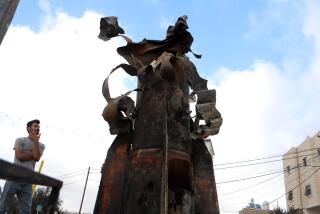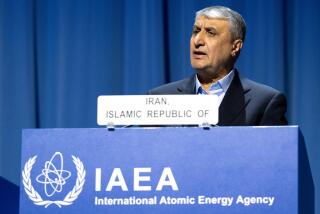No need to ban the bomb
- Share via
Iran’s announcement last month that it will begin enriching uranium for use in a medical reactor sparked a rare bipartisan consensus in Washington. Politicians on both sides of the aisle treated the news as the latest evidence we are moving closer to a nuclear crisis.
There is cause for concern, with Iran unwilling to bend to global pressure, terrorists eager to acquire an atomic device, an erratic North Korea threatening stability in East Asia and an international nuclear nonproliferation regime that appears to be getting weaker by the minute.
So how worried should we be? Not very. These threats, though serious, are overstated. Three common claims in particular are open to scrutiny.
The first is that we are at a nuclear tipping point. Many experts contend the world is on the verge of a proliferation epidemic. By their reasoning, a nuclear Iran might drive Egypt, Saudi Arabia and Turkey into the nuclear club. And North Korea’s nuclear program could leave Japan, South Korea and Taiwan feeling they have little choice but to develop a nuclear capability, perhaps spurring Australia, Indonesia and Malaysia to follow suit.
This threat of “nuclear dominoes” has been exaggerated since the time of President Kennedy, who in 1963 predicted that there could be 25 nuclear weapons states by the 1970s. In fact, the number of nuclear weapons programs in the world has decreased dramatically in the last three decades. South Africa, Ukraine, Kazakhstan and Belarus gave up their weapons, while states such as Australia, Brazil and Sweden abandoned efforts to build the bomb.
Even the weapons programs we worry about most -- Pakistan, Iran and North Korea -- began decades ago, and as far as we know, no new country has started a nuclear weapons program since the end of the Cold War 20 years ago. The most pessimistic predictions of a sudden epidemic of new nuclear states are highly unlikely.
The second overstatement is that a catastrophic terrorist nuclear attack against the United States is inevitable. Eight and a half years after the horrific 9/11 terrorist attacks, we have not had the atomic attack on our soil that many experts predicted. That may be a matter of luck. But it also may be that it is far more difficult than conventional wisdom suggests for a nonstate actor, without secure territory or the institutions of a modern state, to acquire, assemble, transport and detonate a nuclear weapon in an American city.
Nuclear terrorism is not impossible, but rhetoric about the inevitability and catastrophic nature of such an attack does more harm than good.
The third exaggeration is that the threat of rogue nuclear nations today is unprecedented in history. To some, a nuclear Iran or North Korea is so unacceptable as to justify preemptive strikes against their nuclear capabilities. We forget that the so-called rogue threat is not new: The peril presented by a nuclear-armed Mao in the 1960s was far more dangerous than anything Mahmoud Ahmadinejad’s Iran could offer today.
After much debate, the United States ruled out a preemptive attack and learned to live with both a nuclear Russia and China during the Cold War. We should do the same today. Remember, neither of our Cold War enemies used their nuclear weapons or became reckless and undeterrable. Using a nuclear weapon -- or supplying one to a terrorist group -- would invite massive retaliation on the country that struck first, and that is a powerful deterrent.
That Iran -- surrounded by rivals with nuclear ambitions and singled out as dangerous by the largest military power in the world -- has an interest in nuclear weapons is not surprising or irrational. Even analysts who consider Iranian behavior a challenge to U.S. interests do not think it poses a threat as grave as Mao’s China or Stalin’s Soviet Union did. Nuclear weapons could make Iran more aggressive. Or, as with China, they could provide international legitimacy and security, making Iran less irresponsible.
We often portray the post-9/11 world as far more volatile and unsafe than the supposedly stable decades of the Cold War. In fact, nuclear proliferation pressures were greater, our adversaries more ruthless and powerful, and the risks of a nuclear catastrophe higher 40 years ago. Yet despite some close calls, the United States and the world avoided a nuclear calamity during this far more dangerous period.
There are lessons to be learned from the past. First, successful U.S. policies then focused less on who had nuclear weapons than on constructing policies to make sure they were never used, a subtle but important difference. When the United States made potential proliferators and their neighbors feel more secure (or less threatened), they were more likely to stay nonnuclear and, if they went nuclear, to behave more responsibly. Instead of preemption and coercion, a range of options including alliances, security guarantees, reassurance and deterrence drove strategy.
A smarter mix of these policies -- instead of alarmist rhetoric, military threats and isolating sanctions -- could stabilize nuclear politics in places such as the Middle East and East Asia, and build on our 65-year nuclear history of avoiding catastrophe.
Francis J. Gavin is professor of international affairs and director of the Robert S. Strauss Center for International Security and Law, Lyndon B. Johnson School of Public Affairs, University of Texas at Austin.
More to Read
Sign up for Essential California
The most important California stories and recommendations in your inbox every morning.
You may occasionally receive promotional content from the Los Angeles Times.










